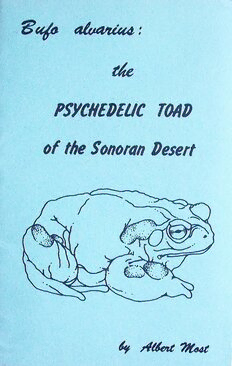
Bufo Alvarius: The Psychedelic Toad of the Sonoran Desert PDF
Preview Bufo Alvarius: The Psychedelic Toad of the Sonoran Desert
Bufo alvarius: the PSYCHEDELIC TOAD of the Sonoran Desert by Albert Most Bufo avarius: The Pyschedelic Toad of the Sonoran Desert by Albert Most Gila, Arizona Summer 1983 To Pat and Quanah Neither the author, illustrator, nor publisher assume any liability for the application of the information contained in this pamphlet. It is presented solely to further the quest for a fuller understanding of the human experience. Specialized multi-cellular glands concentrated on the neck and limbs of B. alvarius produce a viscous milky-white venom that contains large amounts of the potent hallucinogen, 5-MEO-DMT. When va- porized by heat and taken into the lungs in the form of smoke, its indole-based alkaloid produces an incredibly intense psychedelic experience of incredibly short duration. There is no hangover or harmful e↵ect. On the contrary, a pleasant psychedelic afterglow appear quite regularly after smoking the venom of B. alvarius, the Psychedelic Toad of the Sonoran Desert. Part One The Sonoran is a vast irregular-shaped area of some 120,000 square miles. It stretches from southeastern California across the south- ern half of Arizona and extends south into Sonora, Mexico. The desert rises from sea level to more than 5000 feet as arid lowlands of mesquite and creosote are cut by mountain canyons of oak and sycamore. It is a harsh zone where temperatures can reach 140o F in the shade and rainfall amounts at as little as five inches per year. One of the most unique inhabitants of the Sonoran Desert is the native toad, Bufo alvarius. Although the genus Bufo includes more than two hundred species of toads, B. alvarius is the only species that exists exclusively within the Sonoran Desert. Unlike most toads, B. alvarius is semi-aquatic and must remain in the vicinity of depend- able water in order to survive. Consequently, the principle habitat of this species is within the drainage of permanent rivers and streams of the Sonoran Desert. This delicate desert environment, like most places on earth, has not been overlooked by man in his constant compulsion to manipulate nature. But amazingly enough, the semi-aquatic lifestyle of B. alvar- ius has coincided quite well with the advance of civilized man. More than one thousand years ago, the Hohokam Indians began diverting water from the Gila River in order to irrigate the arid soil. Working with sticks and stones these primal people pioneered an extensive system of desert agriculture. Their original network of canals has been expanded for centuries and now irrigates more than 1.5 million acres of the Sonoran Desert. This is equivalent to regularly flooding an area of arid land about half the size of the state of Connecticut. The damp wet desert fields meet man’s increasing needs and simulta- neously provide a permanent niche in the ecosystem for B. alvarius, the semi-aquatic toad of the Sonoran Desert. B. alvarius is nocturnal and remains underground throughout the day, escaping the extreme temperatures with the strategy of subter- ranean life. At dusk, these desert toads leave their hidden recesses and congregate in damp wet areas near springs and streams, in fields irrigated for agriculture, or in temporary pools left after heavy rains. The breeding season, May through July, is the period of greatest activity for B. alvarius. Large healthy toads can easily be gathered after dark using a flashlight and a cloth collection bag. You won’t have any trouble identifying B. alvarius. It is the largest native North American species of toad. In terms of snout-to-vent length, B. alvarius requires a minimum of three inches for sexual ma- turity, although breeding adults continue to grow up to seven inches in length. This desert dweller is of stout build with a squat body and a flat broad head. The skin is smooth and leathery, sparsely covered with pale orange warts, and can change considerably from a dark brown to olive or grayish green. The belly is cream colored and usually unmarked. There are one to four prominent round white warts at the corner of the mouth. But, by far, the most identifying characteristic of B. alvarius is the presence of large granular glands on the neck and limbs. Each of these glands consists of many oval-shaped lobules about two millimeters in diameter. Each lobule is an individual unit with a duct that emerges onto the skin as a well-defined, single pore. A double cell layer surrounds each lobule and functions in the synthesis and release of a viscous milky-white venom. The venom from B. alvarius contains a very peculiar and constant spectrum of biogenic amines. Biosynthesis of the amines is accom- plished via a genetically regulated enzyme system. The metabolic pathway of B. alvarius is unique within the Animal Kingdom in that it produces large amounts of 5-methoxy indole derivatives. The predominant alkaloid among these, as much as fifteen per cent of the venom by dry weight, is 5-methoxy-N, N-dimethyltryptamine (5-MEO-DMT). 5-MEO-DMT is a potent hallucinogen, psychoactive in man at doses of three to five milligrams. It was first synthesized in 1936, but its mind-expanding e↵ects were not discovered for more than twenty years. Then in 1959, 5-MEO-DMT was identified as the predominant alkaloid in the hallucinogenic snu↵s of several tribes in South Amer- ica. These primal people have long prepared mind-altering snu↵s from flowers, seeds, bark, and stems of indigenous plants. In 1968, 5-MEO-DMT was detected in the Animal Kingdom, as well. B. al-
